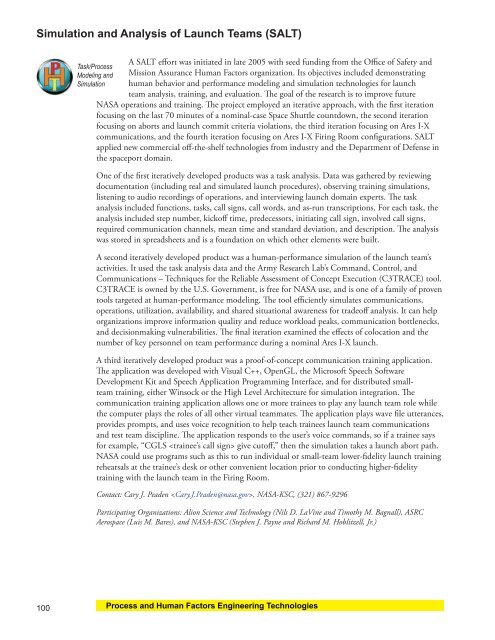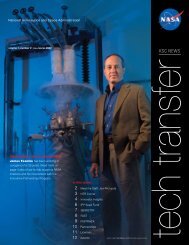2006-2007 - Kennedy Space Center Technology Transfer Office
2006-2007 - Kennedy Space Center Technology Transfer Office
2006-2007 - Kennedy Space Center Technology Transfer Office
- No tags were found...
Create successful ePaper yourself
Turn your PDF publications into a flip-book with our unique Google optimized e-Paper software.
Simulation and Analysis of Launch Teams (SALT)A SALT effort was initiated in late 2005 with seed funding from the <strong>Office</strong> of Safety andTask/ProcessModeling and Mission Assurance Human Factors organization. Its objectives included demonstratingSimulation human behavior and performance modeling and simulation technologies for launchteam analysis, training, and evaluation. The goal of the research is to improve futureNASA operations and training. The project employed an iterative approach, with the first iterationfocusing on the last 70 minutes of a nominal-case <strong>Space</strong> Shuttle countdown, the second iterationfocusing on aborts and launch commit criteria violations, the third iteration focusing on Ares I-Xcommunications, and the fourth iteration focusing on Ares I-X Firing Room configurations. SALTapplied new commercial off-the-shelf technologies from industry and the Department of Defense inthe spaceport domain.One of the first iteratively developed products was a task analysis. Data was gathered by reviewingdocumentation (including real and simulated launch procedures), observing training simulations,listening to audio recordings of operations, and interviewing launch domain experts. The taskanalysis included functions, tasks, call signs, call words, and as-run transcriptions. For each task, theanalysis included step number, kickoff time, predecessors, initiating call sign, involved call signs,required communication channels, mean time and standard deviation, and description. The analysiswas stored in spreadsheets and is a foundation on which other elements were built.A second iteratively developed product was a human-performance simulation of the launch team’sactivities. It used the task analysis data and the Army Research Lab’s Command, Control, andCommunications – Techniques for the Reliable Assessment of Concept Execution (C3TRACE) tool.C3TRACE is owned by the U.S. Government, is free for NASA use, and is one of a family of proventools targeted at human-performance modeling. The tool efficiently simulates communications,operations, utilization, availability, and shared situational awareness for tradeoff analysis. It can helporganizations improve information quality and reduce workload peaks, communication bottlenecks,and decisionmaking vulnerabilities. The final iteration examined the effects of colocation and thenumber of key personnel on team performance during a nominal Ares I-X launch.A third iteratively developed product was a proof-of-concept communication training application.The application was developed with Visual C++, OpenGL, the Microsoft Speech SoftwareDevelopment Kit and Speech Application Programming Interface, and for distributed smallteamtraining, either Winsock or the High Level Architecture for simulation integration. Thecommunication training application allows one or more trainees to play any launch team role whilethe computer plays the roles of all other virtual teammates. The application plays wave file utterances,provides prompts, and uses voice recognition to help teach trainees launch team communicationsand test team discipline. The application responds to the user’s voice commands, so if a trainee saysfor example, “CGLS give cutoff,” then the simulation takes a launch abort path.NASA could use programs such as this to run individual or small-team lower-fidelity launch trainingrehearsals at the trainee’s desk or other convenient location prior to conducting higher-fidelitytraining with the launch team in the Firing Room.Contact: Cary J. Peaden , NASA-KSC, (321) 867-9296Participating Organizations: Alion Science and <strong>Technology</strong> (Nils D. LaVine and Timothy M. Bagnall), ASRCAerospace (Luis M. Bares), and NASA-KSC (Stephen J. Payne and Richard M. Hoblitzell, Jr.)100 Process and Human Factors Engineering Technologies













